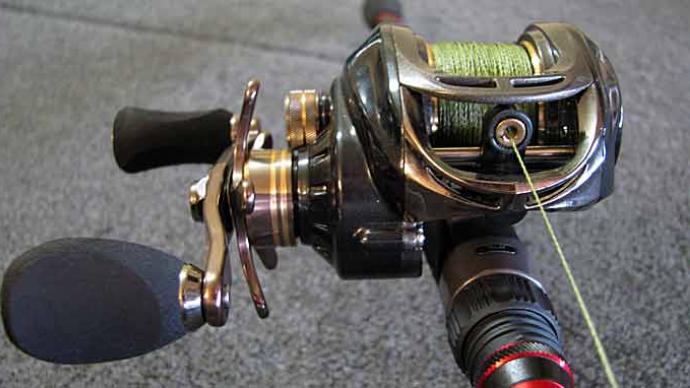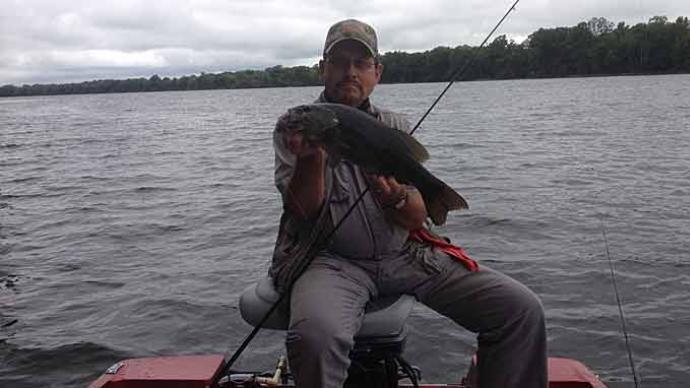I remember many years ago, first getting into baitcasting gear and dreaming about being able to afford reels priced from $80 and more in the display cabinet of my local tackle shop. I settled for $40 reels, and they worked alright. Occasionally, I’d break one, and this is where I learned to take care and service my reels. I couldn’t afford a new reel, but if the part was less than $10 to order, then I called the company and ordered the part.
That was a long time ago, and these days, an $80 reel doesn’t generally even register on my radar when looking at reels. So, it was an exciting opportunity to field test and review the Pinnacle Producer LTE (PRD10LTE) bait caster. Truth told, after fishing with it for a few weeks, I struggled to develop any material for the review. The reel has a pretty smooth retrieve, casts quietly, the drag is sufficient – it even has an excellent indexed, clicking star knob. The overall package is super light yet feels as solid as reels that cost twice as much. My only gripe was that the magnetic brake was inconsistent in settings from 0 to 3. That isn’t a deal-breaker since I generally use more brake than that and run a loose spool.
So, there you have it. What can be said that hasn’t already been said? How about we tear into this reel and look at it side by side with a high-end reel from the same manufacturer? Sounds cool, huh?
I picked the Pinnacle Primmus Xi HS Hand Tuned Casting Reel (PR10XI) because it’s new and, in many aspects, is similar to the Producer: lightweight, general-purpose retrieve ratio, no-frills. In this pictorial breakdown, the Primmus will be on the left, the Producer on the right. That way, you can visually compare each sub-assembly side by side.
Here are our two stars of the show, the Producer in the foreground, since it’s the subject of this article. Both are sharp, modern, and have a typical low-profile form. The gear housings are dropped well below the reel seat mounts, making palming the reels easy, even for anglers with smaller hands. These reels are also narrower than many others – a trend I’ve noticed in the past few years. The Producer lacks some of the visual bling the Primmus shows off, but at $89.99, we’re not concerned with looks as much as construction and functionality. A pretty reel that doesn’t work well is a trap that many in the entry-level category suffer. That isn’t the case here, though it isn’t an ugly reel by any stretch of the imagination either.

The first thing to come off the reel is the handle assembly. Both reels use a swept design and feature a tried and true method for attaching to the crankshaft. I like this look, though some might prefer a prettier chrome cover over the exposed nut retainer and lock screw. The $250 Primmus has a carbon fiber handle, while the Producer handle is swept aluminum. Not surprising, and I will say, if it weren’t because the carbon fiber handle weighed nothing, I’d say the Producer’s aluminum handle weighed next to nothing. It’s light. They both feature high-density EVA knobs supported by not one but two bearings. This is an area where so many reels get short-changed. Knob bearings are so inexpensive and add to the long-term durability. I give Pinnacle a “thumbs up” for going this route, even if it artificially inflates the bearing count. This is one feature that you have to look beyond the marketing department. Remember – it’s where the bearings are that counts more than how many are there!

Next up, after the handle assembly, is the drag star. Look at that. They are almost identical! Both drags are indexed with a reassuring micro click when adjusted. I’ve learned to love this feature, even though I think it’s unnecessary, especially when low mass is a primary target spec for the design. Both work almost identically. I might even give the Producer a slight edge for its “appealing click.” Note there is an extra washer shown on the Producer, but it’s also on the Primmus. It was just camera shy.
Moving on, it’s time to pull the side plates off and remove the spools. While we’re at it, we’ll take the spool tension knob off and see what’s under there.

Now we’re starting to see some differences! The Primmus has an indexed, micro click tension knob, while the Producer does not. This is just a luxury feature, though it’s something I expect once a reel enters the $200 price range. For a sub $100 reel, I’d be shocked to see it and wonder where they skimped to get it in there. Both spools feature a bearing behind the engagement pin, but the Producer has a nylon bushing behind the spool tension cap. Some might cry foul, but think about this – the bearing behind the engagement pin supports the spool in both cases and on the other side by the bearing in the palm side plate. You can see both side plates do indeed have a bearing. If there were a bushing here, I’d be the first to cry foul. Both spools spin freely and smoothly, which translates into casting baits on the water.
You’ll also notice the differences between braking systems by looking closely at the side plates. The Primmus has a simple centrifugal braking system with the push-pull shoes, whereas the Producer uses a typical magnetic system. I prefer a centrifugal brake here, but the magnetic brakes work well once you’ve found your sweet spot.
It’s also worth mentioning that the Producer features “Advanced REF2 Carbon Fiber” side plates. I’m not sure what that is, but the side plates are TOUGH. Many composite side plates flex when you exert pressure on them, especially reels in the sub $100 price range. These are as tough as aluminum or steel side plates but much lighter. Combined with the X-Bone composite frame, the reel is a very solid feeling.

Speaking of the frame, let’s get the crank side plate off and look!

Despite slight differences in the actual parts, the internals are like any other baitcasting reel in any price range. One glaring difference, though, is cast metal components in the spool release/clutch mechanism. It is a refreshing throwback to reels that were built like tanks. Often, these parts are flimsy stamped steel or even some type of plastic. Both reels have a reassuring, solid, mechanical feel when depressing the thumb bar to make a cast. Reengagement of the spool via a quick turn of the handle is equally satisfying.
Below is a closer look at the clutch mechanisms, the Producer on the top, with the gear set removed for a better view. Look at all that metal!

Now, let’s take a closer look at the gear and drag stacks. In a $250 reel, you get a hardened aluminum main gear – rugged and very lightweight. What do you get in a $90 Producer? A hardened aluminum main gear. Wait, what? Yes, it’s true. This was a big surprise to me. This keeps the weight way down. The differences start to show in the drag system. The more expensive reel gets a multi-disk carbon matrix drag stack, an exotic ceramic keyed top washer, and light aluminum alloy washers. The Producer gets a typical steel washer with a Dartanium type drag washer. This may not sound exciting, but remember, this was pretty much state-of-the-art until just a few years ago. Before that, all you got were plastic disks or even cork. I took the Producer, put it on a medium-heavy rod, and took it northern pike fishing, and the drag performed admirably. It was smooth and didn’t suffer from the chatter that some reels suffer from when the drags heat up after line peeling runs. It will work great for typical bass fishing.
Both reels have identical instant anti-reverse roller bearings, dog-eared kick-back gears, and nylon idler gears. The pinion and yokes are similar, though specific to each reel. Both also feature a bearing at the top of the stack. This is often omitted, even on higher-end reels. It provides smoothness and extra stability to the crankshaft and prevents wear on the anti-reverse bearing.

What about those crankshafts? They’re both hardened aluminum, but the Primmus has a hollow shaft. I’m sure this shaves a fraction of a gram but doesn’t seem overly critical.
You can see in detail the clutch engagement parts as well in here. They’re very robust parts, compared to many other brands. The big news here, though, is the bearing at the base. This is the first thing I replace if I find a nylon or brass bushing. It’s very reassuring to see a bearing there. This explains the smoothness of the drive train – all points are supported by a bearing, and two bearings support longer elements. I think I’ve heard something similar marketed as “new” from other brands. It’s nice to see this as the standard operating procedure on an entry-level reel.

Last up, the most fun assembly to take apart (that’s sarcasm, folks!): the level wind. Pinnacle has kept both assemblies as a simple affair. There are no bearings in the Producer - they add weight and do not contribute to performance or smoothness in an adequately designed level wind. The Primmus has a bearing on the geared side of the worm gear. It’s what I call a “nice to have” feature. I think this would cut down on the wear and tear of the worm drive gear and worm gear housing, but these parts rarely wear out in practice. Both worm gears and stabilizer bars are hardened aluminum, which is hardly a big surprise in the breakdown, but it’s another high-end feature-packed into a reasonably priced reel. This has been a running theme throughout the breakdown – one that gets my attention.

That’s all there is left on the reel! You can see an awful lot of innovation and features packed in this reel. That you can take it home at a fraction of the cost of the Primmus is a huge bonus. Is it the same as the Primmus? No. But it’s pretty close. Is it as smooth? It’s hard to tell. Does it cast as far? Sure does. The Primmus can handle baits getting under that magic 3/8-ounce mark just fine. That’s about the limit with this reel. This is a solid choice if you want a good reel for under $100 and want to get out and fish. There’s so much low-end gear not worth even looking at. This was a refreshing change. I’ll be honest, I was a little disappointed to hear this reel would be my subject, but this has been one of the more exciting reviews to date.
For $90, it won’t disappoint, for sure!



